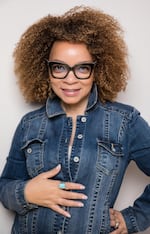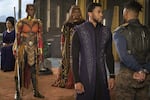Sitting in a film audience for Ryan Coogler’s celebrated Marvel Comics adaptation “Black Panther" you could hear the audience gasp as the camera revealed the riches of Wakanda. A fictional African country blessed with priceless mineral assets and technological power, its true riches stand at the edge of a massive waterfall, to witness a ceremonial battle: the five tribes, each resplendent in traditional colors and styles that are fundamentally African, but untouched by colonial influence.

Costumes by Ruth E. Carter for Marvel's 2018 film "Black Panther."
Courtesy of Ruth E. Carter
The scene is perhaps the most opulent display of Ruth E. Carter’s visionary powers as a designer. Over three decades, she’s built a portfolio of narrative costume work, collaborating with directors like Steven Spielberg, Ava DuVernay, Robert Townsend, Joss Whedon, John Singleton and most famously, Spike Lee.
Carter will be a keynote speaker at Cre8con, the Portland Creative Conference on Friday, Sept. 27 in the Gerding Theatre at the Armory in downtown Portland.

Designer Ruth E. Carter won an Academy Award for her work on Ryan Coogler's "Black Panther."
Courtesy of Ruth E. Carter
Ruth E. Carter is no stranger to large-scale productions, but she said the process for “Black Panther” was intense. There were thrice-weekly meetings with 25 Marvel executives, art director Hannah Beachler, special effects staff and set designers, among others. Her L.A. team of seven coordinated with vendors and a staff of 20 in Atlanta on sewing, crafts, jewelry and other jobs for the film set.
“Hannah [Beachler] worked on a large manual with Ryan [Coogler] before we started — just to be very clear what this world was like: the daily activities, the different tribes,” Carter said. “That helped me. Ryan was also very vocal about what the looks should be.”
She made dozens of mood boards, with photos and samples from African cultures and of contemporary fashions by Issey Miyake and other designers. Once Coogler approved of a concept, the team would start on the prototypes. Sometimes finished products came from last-minute inspirations; Carter tells the story of a headdress inspired by traditional Maasai headgear, improvised on a rushed shopping trip to Pier One Imports. Other creations, like the iconic dress of the Wakandan royal guard, the Dora Milaje, were the subject of intense discussion.

Representatives of Wakanda's mining tribe. The Maasai-inspired headdress on the warrior at the center was a last-minute creation originating from a beaded placemat, said designer Ruth E. Carter.
Courtesy of Ruth E. Carter
“Ryan wanted them to be taken seriously,” Carter said. “This was a uniform they were wearing. It didn’t need to be skimpy. It had to protect their vitals. He wanted them to be martial artists, so they had to have their shoes flat to the ground. The whole Marvel team was involved.”
The deliberate thinking that went into each character paid off in a world that audiences could respond to and draw on as a source of empowerment.
Carter was on set for a turning point in American cinema in the 1990s, when black directors like Lee and Singleton were showing studios the range of stories black cinema could tell. While her Oscar nomination for Lee's "Malcolm X" opened doors to work with more mainstream films, she still represents a gold standard for visual storytelling, especially in films like DuVernay's "Selma," in which subtle choices in Carter's color palette communicated volumes about the front line of the Southern social justice movement.
Today, Carter said, she’s retained some of the same ideas about character and emotion that mark her early work. (She was motivated by photographers like Harlem’s James Van Der Zee or Pittsburgh’s Charles “Teenie” Harris.) But her vibrant career has given her a grasp of the contextual environments in which characters live.
“So by the time I got to ‘Black Panther,’ I knew how to create a world, and be authentic to it,” she said.

While the basic design of the Black Panther costume worn by Chadwick Boseman came together before Ruth E. Carter came on the project, she had many opportunities to bring her sensibility to the character of King T'Challa, adding detail and texture to the suit, and dressing him for non-action sequences.
Courtesy of Ruth E. Carter
Carter spoke to us while preparing for a production of “Coming 2 America,” the sequel to Eddie Murphy’s 1988 comedy (a film that premiered the same year as Carter’s costuming debut, on Spike Lee’s “School Daze”). She recently wrapped up work on another Murphy picture, a Netflix biopic of comedian and filmmaker Rudy Ray Moore, entitled “Dolemite Is My Name.”
At Cre8Con, she'll share stories from many of her award-winning designs and talk about her process, alongside other luminaries like Emmy-winning production designer Schuyler Telleen, and Eisner Award-winning comic book writers Kelly Sue DeConnick and Matt Fraction.
